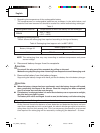
English
21
5. When driving wood screws (Fig. 15)
(1) Selecting a suitable driver bit
Employ plus-head screws, if possible, since the
driver bit easily slips off the heads of slotted-head
screws.
(2) Driving wood screws
⅜ Prior to driving wood screws, make pilot holes
suitable for them in the wooden board. Apply the
bit to the screw head grooves and gently drive
the screws into the holes.
⅜ After rotating the rotary hammer at low speed for
a while until a wood screw in partly driven into
the wood, squeeze the trigger more strongly to
obtain the optimum driving force.
CAUTION:
● Exercise care in preparing a pilot hole suitable for
the wood screw taking the hardness of the wood
into consideration. Should the hole be excessively
small or shallow, requiring much power to drive
the screw into it, the thread of the wood screw
may sometimes be damaged.
6. Using depth gauge (Fig. 16)
(1) Loosen the knob on the side handle, and insert
the depth gauge into the mounting hole on the
side handle.
(2) Adjust the depth gauge position according to the
depth of the hole and tighten the knob bolt
securely.
7. How to use the drill bit (taper shank) and the
taper shank adaptor
(1) Mount the taper shank adaptor to the rotary
hammer. (Fig. 17)
(2) Mount the drill bit (taper shank) to the taper shank
adaptor. (Fig. 17)
(3) Turn the switch ON, and drill a hole in prescribed
depth.
(4) To remove the drill bit (taper shank), insert the
cotter into the slot of the taper shank adaptor and
strike the head of the cotter with a hammer
supporting on the rests. (Fig. 18)
Rests
Taper shank
adaptor
Cotter
Fig. 18
Front cap
Grip
Taper
shank
adaptor
Mounting hole
Depth
gauge
Side handle
Fig. 16
Fig. 17
Drill
bit
01e_dh24dv_e.p65 copy 4/14/04, 5:49 PM21


















